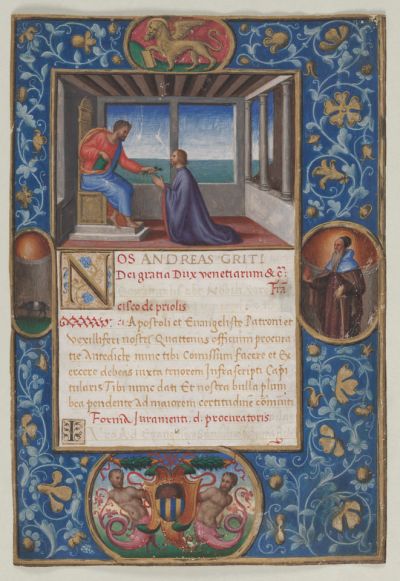La Madonna col Bambino del Cleveland Museum of Art è un esempio particolarmente bello di questo soggetto, sebbene sfortunatamente non sia noto per quale chiesa o cappella di Siena fu dipinto quasi 700 anni fa o da chi fu commissionato. Lo stile ne suggerisce l’attribuzione all’artista senese Lippo Memmi, cognato del più celebre Simone Martini. Di certo si sa che l’opera formava una volta il pannello centrale di una pala d’altare. La Madonna aleggia su una cornice d’oro puro che nei primi dipinti italiani suggerisce il regno del paradiso. Qui, Maria culla il Cristo Bambino che a sua volta si aggrappa ai vestiti di sua madre tenendo in una mano un rotolo di pergamena che proclama il suo destino speciale. L’immagine è al tempo stesso una tenera celebrazione dell’amore materno ed una triste premonizione della Passione di Cristo. Mentre i volti della madre e del bambino sono affettuosamente vicini uno all’altro, i loro sguardi lontani tradiscono la consapevolezza del dolore profondo che si prospetta. Nel dipinto Cristo strattona il mantello della madre come farebbe un qualsiasi bambino, mentre la stella decorata sulla spalla della Madonna si riferisce alla ‘stella maris”, parole contenute in un inno cantato dai senesi nei giorni di festa in onore della amata protettrice.
In the Trecento, the Italian peninsula was occupied by numerous independent kingdoms, communes and city states that did not always live in harmony. The period saw the generally sustained growth of thriving urban centers teeming with mercantile wealth and ever-growing populations in which bankers, merchants, tradesmen, and craftsmen formed an emerging middle class. Italy’s cities, like Siena and Florence, emerged during the period as the pre-eminent domains of power, culture and knowledge. At their center, rose large cathedrals, palaces and civic buildings, all requiring religious art and funded by communal governments or aristocratic rulers as symbols of authority and wealth.
Among the great medieval Italian cities that are well-represented in the collections of the Cleveland Museum of Art is the Tuscan city of Siena. Tourists who visit Siena today will marvel at its richly preserved medieval streets, its famed Duomo and the Piazza del Campo. Those who wish to explore Siena’s important contribution to art without extensive travel may alternatively visit the museum’s newly installed galleries on level one of the original 1916 building. There, examples of Sienese painting from the Trecento illustrate this city’s enduring legacy in the history of art. Visitors will, however, note the abundance of paintings representing the subject of the “Madonna and Child,” emblematic perhaps of this city’s particular affection for Mary.
A particularly beautiful example of this subject now in the Cleveland Museum of Art is the “Madonna and Child.” This painting once formed the central panel of an altarpiece. The Madonna hovers over a pure gold surround that in early Italian paintings suggests the realm of heaven. Here, Mary cradles the Christ Child who in turn clings to his mother’s clothing. He also holds a scroll that proclaims his special destiny. The image is both a tender celebration of Mary’s maternal love and a sad foreshadowing of Christ’s Passion, yet to come. While the faces of the mother and child are pressed affectionately together, their distant gazes betray their knowledge of the grief that lay ahead, when the Madonna will again press her face to her child’s as he is placed in the tomb. In our painting, Christ tugs at his mother’s mantle as any mortal child might—a precious moment of tenderness. The star emblazoned on the Madonna’s shoulder refers to the “stella maris” (star of the sea), the words of a hymn sung at vespers and on feast days honoring her. In this way, the painting offered its original Sienese viewers the chance to contemplate many aspects of their beloved patroness and protector.
For which church or chapel in Siena was this painting made? Who commissioned the artist to paint it? As beautiful and as touching as this painting is, we sadly do not know. Separated in time by almost 700 years, that information is not recorded and such is the challenge of the modern art historian. Yet, we should continually remind ourselves that this, and other paintings like it, were seen and used by real people in the historical past.
The style of our “Madonna and Child” suggests it was painted by the Sienese artist, Lippo Memmi (ca. 1291-1356), the brother-in-law of the better-known and extremely influential painter, Simone Martini (ca. 1284-1344). The two artists worked closely together and the museum’s “Madonna and Child” reflects Simone’s influence on Memmi in its aristocratic and elegant style. Memmi is known to have worked at Orvieto Cathedral and later followed his brother-in-law to the Papal Court at Avignon. After his return to Siena, Memmi continued to work until his death in 1356. Memmi is remembered for distinctive stamped tin halos with ray patterns in gold leaf. This interest in design carries over to Memmi's observation of fabric patterns as may be noted on the museum’s painting.
The beautiful panel painting of the “Madonna and Child” by Lippo Memmi transports us to the vibrant moment in Siena’s rich history as the city struggled to cope with its recovery from the Plague of 1347. Perhaps the city’s patroness, our “Madonna and Child” by Lippo Memmi, offered solace and comfort to those who prayed before her.



